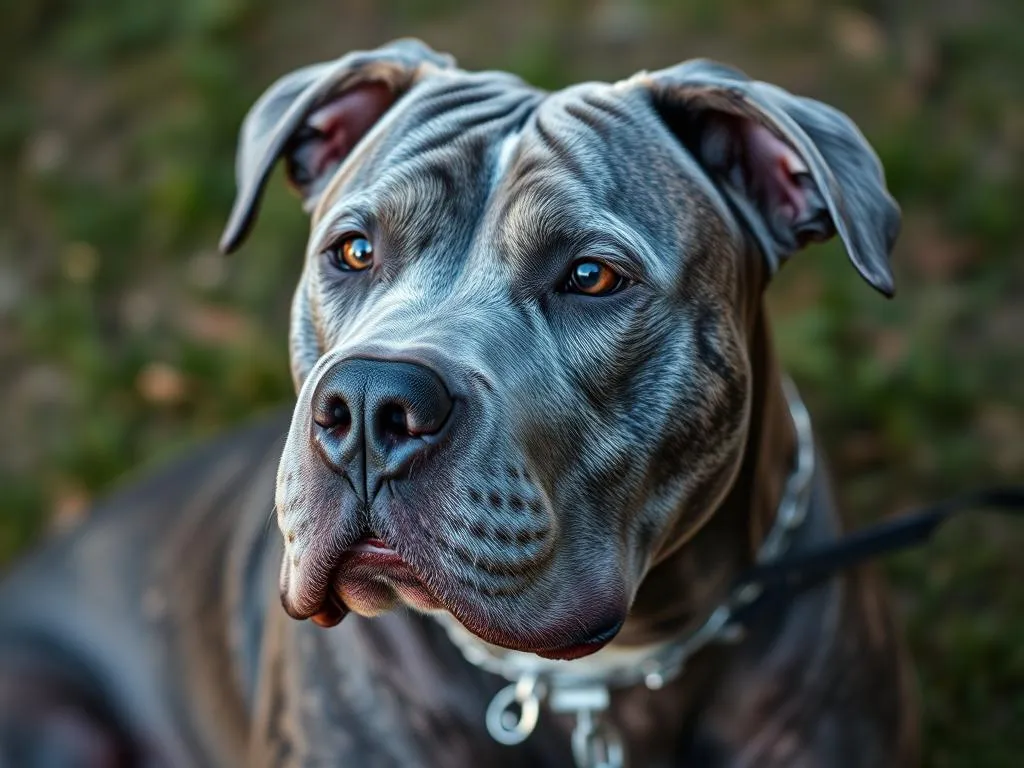
Introduction
Dog breeds are not just classifications; they represent a rich tapestry of history, genetics, and human companionship. Each breed comes with its unique traits, characteristics, and care needs. Among these, the blue brindle pitbull stands out as a captivating variant that combines a striking appearance with a loyal temperament. This article delves into the nuances of the blue brindle pitbull, exploring its characteristics, care requirements, and much more.
Understanding Dog Breeds
Definition of Dog Breeds
A dog breed is a specific group of domestic dogs with particular features and traits that distinguish them from other groups. These traits can be physical, such as size and coat color, or behavioral, including temperament and energy levels. Understanding dog breeds is crucial for potential dog owners, as it helps in selecting a breed that matches their lifestyle and preferences.
The Role of Genetics in Dog Breeds
Genetics plays a pivotal role in determining a dog’s characteristics. The traits of a specific breed are passed down from generation to generation, influencing everything from physical appearance to behavioral tendencies. In the case of the blue brindle pitbull, genetics dictate not only its distinctive coat color but also its muscular build and personality traits.
Popularity of Different Breeds
Certain breeds have gained popularity across various regions due to their temperament, appearance, and suitability for families. According to recent statistics, the Pitbull, including its color variations like the blue brindle pitbull, is among the most popular breeds in the United States, often favored for their loyalty and protective nature.
The Blue Brindle Pitbull
What is a Blue Brindle Pitbull?
The blue brindle pitbull is a variant of the American Pit Bull Terrier known for its unique coat pattern. The term “brindle” refers to a distinctive striped pattern in the coat, which can vary significantly in intensity and distribution. The “blue” in its name refers to the diluted black gene that gives the coat a grayish hue. This combination results in a visually striking dog that is as beautiful as it is loyal.
The Pitbull breed itself has a rich history, originally bred for bull-baiting and later for companionship and farm work. Their reputation has shifted over the years, often landing them in the spotlight for their strength and loyalty.
Physical Characteristics
Size and Weight
The blue brindle pitbull typically stands between 17 to 21 inches tall at the shoulder and weighs between 30 to 85 pounds, depending on gender and genetic factors. Males are generally larger than females.
Coat Texture and Coloration Details
The coat of a blue brindle pitbull is short and smooth, making grooming relatively easy. The brindle pattern can vary significantly, with some dogs exhibiting a more pronounced striping effect than others. The blue coloration can range from a silvery gray to a darker slate, often combined with the classic brindle pattern.
Distinctive Features
One of the most recognizable features of the blue brindle pitbull is its muscular build, characterized by broad shoulders and a strong chest. Their ears may be cropped or left natural, contributing to their distinctive appearance. Their expressive eyes can convey a wide range of emotions, often deepening the bond with their owners.
Temperament and Behavior
Common Personality Traits
Blue brindle pitbulls are known for their affectionate and loyal nature. They are often described as friendly, playful, and eager to please, making them excellent companions for families and individuals alike. Their intelligence allows them to learn commands quickly, but they also require consistent training and socialization.
Comparison with Other Pitbull Color Variations
While the blue brindle pitbull shares many traits with other Pitbull color variations, such as the classic red or fawn, the brindle pattern adds a unique aesthetic appeal. Temperament can vary slightly based on genetics and upbringing, but overall, all Pitbulls are known for their loyalty and protective instincts.
Socialization Needs and Typical Behavior Patterns
Socialization is crucial for a blue brindle pitbull, as it helps prevent behavioral issues and ensures they grow into well-rounded adults. Regular interactions with other dogs and people will enhance their social skills and reduce anxiety or aggression.
Care and Maintenance
Grooming Needs
Brushing Frequency and Techniques
The grooming needs of a blue brindle pitbull are relatively low, thanks to their short coat. Brushing once a week is generally sufficient to remove loose hair and keep their coat healthy. A rubber grooming glove or a soft-bristle brush can effectively remove dirt and debris.
Bathing Guidelines
Bathing should be done as needed, typically every few months or when the dog gets particularly dirty. Use a gentle dog shampoo to avoid stripping the coat of its natural oils.
Diet and Nutrition
Recommended Diet for Blue Brindle Pitbulls
A balanced diet is essential for maintaining the health and energy levels of a blue brindle pitbull. High-quality dog food that lists meat as the primary ingredient is ideal. Consult with a veterinarian for specific dietary recommendations based on age, weight, and activity level.
Common Dietary Restrictions and Allergies
Pitbulls, including the blue brindle pitbull, can be prone to food allergies. Common allergens include grains, beef, and chicken. Observing your dog’s reactions to different foods and consulting a vet can help identify any dietary restrictions.
Exercise Requirements
Daily Exercise Needs and Activities Suited for the Breed
Blue brindle pitbulls are energetic dogs that require daily exercise to maintain their health and happiness. Aim for at least 30 to 60 minutes of physical activity each day, which can include walks, playtime, or agility training.
Importance of Physical and Mental Stimulation
In addition to physical exercise, mental stimulation is vital for a blue brindle pitbull. Puzzle toys, training sessions, and interactive games can keep their minds sharp and reduce behavioral issues stemming from boredom.
Health Considerations
Common Health Issues in Pitbulls
Like all breeds, blue brindle pitbulls can be prone to certain health issues, including hip dysplasia, skin allergies, and certain heart conditions. Regular veterinary check-ups and a healthy lifestyle can help mitigate these risks.
Preventative Care and Regular Vet Check-ups
Routine vet visits are essential for maintaining the health of a blue brindle pitbull. Vaccinations, parasite control, and dental care should be part of their healthcare routine to ensure longevity and quality of life.
Training a Blue Brindle Pitbull
Importance of Early Training
Early training is crucial for the development of a well-behaved blue brindle pitbull. Starting training at a young age helps establish good habits and social behaviors, which can prevent future behavioral problems.
Training Techniques
Positive Reinforcement Methods
Using positive reinforcement is one of the most effective training techniques for blue brindle pitbulls. Rewarding good behavior with treats, praise, or playtime encourages them to repeat those behaviors. This method fosters a trusting relationship between the dog and owner.
Basic Commands and Advanced Training Tips
Teaching basic commands like “sit,” “stay,” and “come” is essential for any dog, including the blue brindle pitbull. As they master the basics, consider introducing more advanced commands or tricks to keep them engaged and mentally stimulated.
Socialization
Importance of Socializing with Other Animals and Humans
Socialization is key to a well-rounded blue brindle pitbull. Exposing them to various environments, people, and other animals helps them develop confidence and reduces the likelihood of fear-based aggression.
Recommended Socialization Practices
Start socialization early, exposing your blue brindle pitbull to different situations, such as parks, pet stores, and playdates with other dogs. Positive experiences during these interactions will help them grow into friendly and well-adjusted adults.
Blue Brindle Pitbulls in Popular Culture
Representation in Media
Popular Movies and Shows Featuring Pitbulls
Pitbulls, including the blue brindle pitbull, have made notable appearances in various movies and television shows, often depicted as loyal companions. Their portrayal in media can influence public perception, highlighting their strength and affection.
Misconceptions and Stigma
Addressing Common Misconceptions About Pitbulls
Despite their popularity, blue brindle pitbulls often face misconceptions regarding their temperament and behavior. Many believe they are inherently aggressive, which is largely unfounded. Responsible ownership and proper training are critical in shaping a dog’s behavior.
The Impact of Breed-Specific Legislation
Breed-specific legislation can unfairly target Pitbulls, leading to restrictions or bans in certain areas. Advocating for responsible ownership and educating communities about the true nature of these dogs can help combat stigma and promote acceptance.
Finding a Blue Brindle Pitbull
Adoption vs. Breeding
Pros and Cons of Adopting vs. Buying from a Breeder
Adoption offers a chance to provide a home for a dog in need, often at lower costs. However, purchasing from a reputable breeder allows for more knowledge about the dog’s lineage and health. Weighing these options is crucial for prospective owners.
What to Look for in a Breeder or Shelter
Key Characteristics of Responsible Breeders
When seeking a blue brindle pitbull, look for breeders who prioritize health testing, socialization, and responsible breeding practices. A good breeder should be willing to answer questions and provide references.
Questions to Ask When Adopting
Inquire about the dog’s history, health records, and any behavioral issues when adopting from a shelter. Understanding the dog’s background will help you prepare for its integration into your home.
Cost Considerations
Average Costs of Adoption and Purchasing
The costs associated with adopting a blue brindle pitbull can range from $100 to $300, while purchasing from a breeder may start at $1,000 and can go much higher depending on lineage and demand.
Long-Term Financial Commitment of Owning a Dog
Owning a dog involves ongoing costs, including food, grooming, veterinary care, and training. It’s essential to consider these long-term commitments when deciding to bring a blue brindle pitbull into your life.
Conclusion
The blue brindle pitbull is a unique and captivating breed, characterized by its striking appearance and loyal disposition. Understanding their care, training needs, and socialization requirements is essential for any potential owner. With proper training and love, a blue brindle pitbull can be a wonderful addition to any family, offering companionship and joy for years to come.
The joys and responsibilities of dog ownership are significant, but the bond you cultivate with a blue brindle pitbull will undoubtedly be rewarding. Whether you choose to adopt or purchase, being informed and prepared will ensure a happy and fulfilling experience for both you and your dog.







